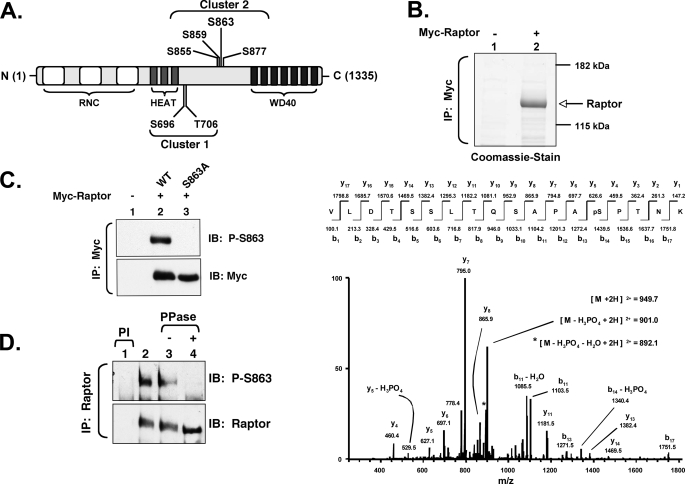FIGURE 2.
Identification of Ser863 as a site of raptor phosphorylation in intact cells and generation of phosphospecific Ser863 antibodies. A, localization of cluster 1 (Ser696/Thr706) and cluster 2 (Ser855/Ser859/Ser863/Ser877) P-sites within the domain structure of raptor. The six P-sites identified map to a central, poorly conserved region of raptor that localizes between the N-terminal RNC (raptor N-terminal conserved) domains and HEAT repeats and the C-terminal WD40 repeats. B, low energy, collision-induced dissociation spectrum of the doubly charged raptor Ser(P)863 phosphopeptide. HEK293 cells were transfected with Myc-raptor, cultured in DMEM/FBS, and WCL was immunoprecipitated (IP) with Myc antibodies. A Coomassie-stained band of Myc-raptor (upper panel) was digested with trypsin after SDS-PAGE. Liquid chromatography-MS/MS and data analysis were conducted as described under “Experimental Procedures.” Note that the y4–y7 ion series clearly places the site of phosphorylation on Ser863. C, Ser(P)863 antibodies are site-specific. HEK293 cells were transfected with vector control (−) or with WT or S863A Myc-raptor alleles, as indicated. WCL was immunoprecipitated (IP) with Myc antibodies and immunoblotted (IB) with the indicated antibodies. D, Ser(P)863 antibodies are phosphospecific. HEK293 lysate was immunoprecipitated with preimmune (PI) antibodies (lane 1) or with anti-raptor antibodies (lanes 2–4). The immunoprecipitates were resuspended immediately in sample buffer (lanes 1 and 2) or washed in phosphatase (PPase) buffer and incubated in the absence (lane 3) or presence (lane 4) of λ-phosphatase. The immunoprecipitates were immunoblotted as indicated.

